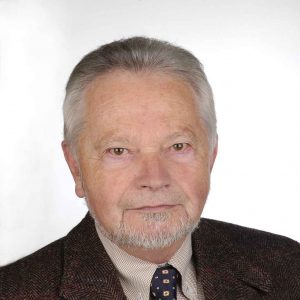prof. dr hab. Adam Patkowski

Zainteresowania naukowe
- Struktura, dynamika i oddziaływania miękkiej fazy skondensowanej (koloidy, ciecze tworzące szkło, polimery, biopolimery)
- Statyczne i dynamiczne (korelacja fotonów) metody rozpraszania światła (PCS, FPI), promieniowania synchrotronowego (SAXS, XPCS), neutronów (SANS) i fluorescencji (FCS)
Wykształcenie
- I Liceum Ogólnokształcące im. Karola Marcinkowskiego w Poznaniu – matura 1966
- Magister fizyki – Uniwersytet A. Mickiewicza, Wydział Matematyki, Fizyki i Chemii, 1971,
- Doktor fizyki – Uniwersytet A. Mickiewicza, Wydział Matematyki, Fizyki i Chemii, 1975,
- Habilitacja z fizyki – Uniwersytet A. Mickiewicza, Wydział Matematyki, Fizyki i Chemii, 1982,
- Tytuł profesora nauk fizycznych – Uniwersytet A. Mickiewicza, Wydział Matematyki, Fizyki i Chemii, 1992,
- Profesor zwyczajny – Fizyka – Uniwersytet A. Mickiewicza, Wydział Matematyki, Fizyki i Chemii, 1996
Inne informacje
Zatrudnienie
Uniwersytet im. Adama Mickiewicza w Poznaniu, Wydział Mat-Fiz-Chem, potem Wydział Mat-Fiz, potem Wydział Fizyki:
- asystent: 1971-1974,
- starszy asystent: 1974-1975,
- adiunkt: 1975-1983,
- docent (prof. UAM): 1983-1992,
- profesor: 1992-1996,
- profesor zwyczajny: od 1996
Staże zagraniczne
- Research Associate, Chemistry Department, State University of New York at Stony Brook, Associated with Prof. B. Chu, 3 years (1975-1980),
- Visiting Professor, Chemistry Department, University of Bielefeld, Germany, Sept. 1985 – Feb. 1987,
- Project Leader, Max Planck Institute for Polymer Research, Mainz, Germany, 1991-1999,
- Visiting Professor, Forschungszentrum Juelich, Istitut fuer Festkoerperforschung, Weiche Materie, 1.03.-31.08.2006.
Przynależność do towarzystw naukowych
- Polskie Towarzystwo Fizyczne
- Polskie Towarzystwo Biofizyczne
2021
Litowczenko, Jagoda; Gapiński, Jacek; Markiewicz, Roksana; Woźniak, Anna; Wychowaniec, Jacek K; Peplińska, Barbara; Jurga, Stefan; Patkowski, Adam
Synthesis, characterization and in vitro cytotoxicity studies of poly-N-isopropyl acrylamide gel nanoparticles and films Journal Article
In: Materials Science and Engineering: C, vol. 118, pp. 111507, 2021, ISSN: 0928-4931.
Abstract | Links | BibTeX | Tagi: Cell cytotoxicity, Dynamic light scattering, Films, Hydrogels, Poly-N-isopropyl acrylamide (pNIPAM), Swelling and deswelling properties
@article{LITOWCZENKO2021111507,
title = {Synthesis, characterization and in vitro cytotoxicity studies of poly-N-isopropyl acrylamide gel nanoparticles and films},
author = {Jagoda Litowczenko and Jacek Gapiński and Roksana Markiewicz and Anna Woźniak and Jacek K Wychowaniec and Barbara Peplińska and Stefan Jurga and Adam Patkowski},
url = {http://www.sciencedirect.com/science/article/pii/S0928493120334251},
doi = {https://doi.org/10.1016/j.msec.2020.111507},
issn = {0928-4931},
year = {2021},
date = {2021-01-01},
journal = {Materials Science and Engineering: C},
volume = {118},
pages = {111507},
abstract = {In this work, we show synthesis that leads to thermoreponsive poly-N-isopropyl acrylamide (pNIPAM) nanogels with sizes below 100 nm, irrespectively of the surfactant to crosslinker ratio. We also show that in many environments the temperature induced pNIPAM collapse at Lower Critical Solution Temperature (LCST) of 32.5 °C is accompanied by gel nanoparticles' aggregation. Thus, the proper information on the nanoparticle (NP) structure and deswelling can be obtained only if the routinely measured hydrodynamic radius is supplemented by information on the molecular weight, which can be obtained from the intensity of scattered light. We measured the dynamics and reversibility of the deswelling and subsequent aggregation processes. Furthermore, we show that the highly concentrated pNIPAM gel NPs reversibly form bulk hydrogel networks of varied interconnected porous structure. We show, that in case of drying pNIPAM gel NPs above the LCST, it is possible to obtain films with 20-fold increase in storage modulus (G′) compared to hydrogel networks measured at room temperature. They exhibit temperature hysteresis behavior around LCST of 32.5 °C similar to pNIPAM films. Finally, we show that these hydrogel films, lead to extended proliferation of cells across three different types: fibroblast, endothelial and cancer cells. Additionally, none of the films exhibited any cytotoxic effects. Our study brings new insights into physicochemical characterization of pNIPAM gel NPs and networks behavior in realistic conditions of in vitro measurements, especially by means of dynamic light scattering as well as final unique properties of both gel NPs and formed porous films for possible tissue engineering applications.},
keywords = {Cell cytotoxicity, Dynamic light scattering, Films, Hydrogels, Poly-N-isopropyl acrylamide (pNIPAM), Swelling and deswelling properties},
pubstate = {published},
tppubtype = {article}
}
In this work, we show synthesis that leads to thermoreponsive poly-N-isopropyl acrylamide (pNIPAM) nanogels with sizes below 100 nm, irrespectively of the surfactant to crosslinker ratio. We also show that in many environments the temperature induced pNIPAM collapse at Lower Critical Solution Temperature (LCST) of 32.5 °C is accompanied by gel nanoparticles' aggregation. Thus, the proper information on the nanoparticle (NP) structure and deswelling can be obtained only if the routinely measured hydrodynamic radius is supplemented by information on the molecular weight, which can be obtained from the intensity of scattered light. We measured the dynamics and reversibility of the deswelling and subsequent aggregation processes. Furthermore, we show that the highly concentrated pNIPAM gel NPs reversibly form bulk hydrogel networks of varied interconnected porous structure. We show, that in case of drying pNIPAM gel NPs above the LCST, it is possible to obtain films with 20-fold increase in storage modulus (G′) compared to hydrogel networks measured at room temperature. They exhibit temperature hysteresis behavior around LCST of 32.5 °C similar to pNIPAM films. Finally, we show that these hydrogel films, lead to extended proliferation of cells across three different types: fibroblast, endothelial and cancer cells. Additionally, none of the films exhibited any cytotoxic effects. Our study brings new insights into physicochemical characterization of pNIPAM gel NPs and networks behavior in realistic conditions of in vitro measurements, especially by means of dynamic light scattering as well as final unique properties of both gel NPs and formed porous films for possible tissue engineering applications.